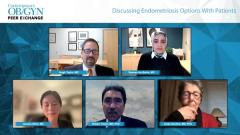
Endometriosis: GnRH Antagonists and Trial Data
A panel of experts provide an overview of GnRH antagonists trial data for the treatment of endometriosis.
Episodes in this series

Hugh Taylor, MD: Let’s talk in a little more detail about the GNRH antagonists. There are 2 approved for the treatment of endometriosis in the United States, and they’re relatively new to the market. We’ve had elagolix for a few years, and relugolix just received approval recently, but many practitioners are still not familiar with them. Linda, since you led 1 of the phase 3 trials that led to the approval of relugolix in the United States, give an overview of GNRH antagonist action and the 2 available GNRH antagonists.
Linda Giudice, MD, PhD: GNRH antagonists block GNRH action directly at the receptor, in contrast with the GNRH agonists that first deplete the pituitary and then block further secretion of gonadotropins. There’s no flare effect. GNRH antagonists about have short half-lives. They are oral, and they’re being used more, but we have a long way to go. With regard to relugolix, there were 2 pivotal trials, and Susie [Sawsan As-Sanie] was part of them: there were over 600 patients in SPIRIT 1 and SPIRIT 2. The lower age limit cutoff was 18 years old, so it wasn’t the more pediatric population.
The trial was initially for 24 weeks with randomization, and it was placebo controlled. There were 3 arms. [The first arm was] relugolix combination therapy, a combination of 1 mg of estradiol plus 0.5 mg of norethindrone acetate plus relugolix at 40 mg. The second arm was relugolix alone for 12 weeks and then switched to the combination therapy for the remaining 12 weeks of the 24-week trial. The third group was the placebo control. There were 2 primary outcomes, as the FDA requires. One was the improvement of dysmenorrhea scores, and the other was nonmenstrual pelvic pain. Of the responders, there was about a 78% response rate to relugolix combination therapy for dysmenorrhea. With the placebo, it was 30% or 40%. With regard to nonmenstrual pelvic pain, the response rate was about 68% compared with 30% or 40% in the placebo group. Nonmenstrual pelvic pain is always more complicated than dysmenorrhea, and it’s likely why there’s a difference in response rates.
The trials were predicated on the [Robert] Barbieri hypothesis, that estradiol would be in the early proliferative-phase range, around 40 to 60 pg/mL. That’s sufficient to maintain bone density, but not enough to stimulate endometriosis or pain. Indeed, the bone mineral density studies showed very minimal bone loss over a 24-week period in patients on combination therapy. There was more bone loss in the relugolix alone, in the 12 weeks, than with the add-back and the combination that bone density improved. On the placebo control there was very little bone loss. That’s the bottom line with regard to 1 of the issues for GNRH antagonists and GNRH agonists with regard to profound estrogen decrease. But they’re not quite as profound, in terms of estrogen suppression, as the GNRH agonists have been. I should mention 1 other thing in terms of initiating therapy. The FDA approved therapy for 2 years on the higher dosage of 200 mg twice a day for 6 months and 150 mg once a day for 2 years. I tend to get a bone-density scan at the beginning as a baseline because there are a lot of variables.
Hugh Taylor, MD: That’s very interesting. Those are 2 different approaches. The relugolix is released as a combination therapy, so it has the add-back built-in. The elagolix approach is without add-back at 2 different doses that give you that partial suppression and greater suppression. With the higher dose of elagolix, the results were somewhat comparable, similar to the relugolix combination therapy. But the lower dose of elagolix a little less effective, although it had a longer duration. I tend to use the lower dose of elagolix for those with milder forms of pelvic pain. In these trials, you had to have moderate to severe pain, and it looked at those with the worst pain. I tend to use the low-dose elagolix for those who may have done OK on an oral contraceptive but have estrogen-related adverse effects, or I taper them down to that if they’ve been on the higher dose for a while. Also, with the elagolix, the trials were all done without add-back therapy. If I have patients with vasomotor symptoms, I may use some add-back therapy. But that’s off-label; it’s not the approved indication.
TRANSCRIPT EDITED FOR CLARITY
Newsletter
Get the latest clinical updates, case studies, and expert commentary in obstetric and gynecologic care. Sign up now to stay informed.


























